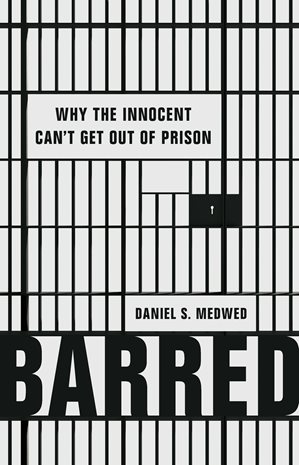Author Chats
Daniel S. Medwed Exposes Deep Harms of Expedient Justice in Wrongful Convictions
December 13, 2022
In Barred: Why the Innocent Can’t Get Out of Prison, Northeastern University Distinguished Professor of Law.jpg?width=299&height=450) and Criminal Justice Daniel S. Medwed draws upon his yearslong work as an innocence advocate to describe the many procedural barriers faced by the wrongfully convicted. In his trenchant critique of the criminal justice system, Medwed includes the personal narratives of innocent individuals, most of whom would spend decades behind bars.
and Criminal Justice Daniel S. Medwed draws upon his yearslong work as an innocence advocate to describe the many procedural barriers faced by the wrongfully convicted. In his trenchant critique of the criminal justice system, Medwed includes the personal narratives of innocent individuals, most of whom would spend decades behind bars.
Prior to joining Northeastern, Medwed taught at the University of Utah S. J. Quinney College of Law and at Brooklyn Law School, where he oversaw its Second Look Program that investigated and litigated claims of innocence by New York inmates. He is also the author of Prosecution Complex: America’s Race to Convict and Its Impact on the Innocent, published in 2012.
Here, Medwed speaks about his criticisms and his vision for a revamped criminal justice system that places a just outcome ahead of the desire for a swift and final judgment.
What was your impetus for writing this book?
By now we all know the factors that can lead to wrongful convictions at trial. Eyewitnesses make mistakes, prosecutors and police commit misconduct, the government relies on flawed forensic evidence and unreliable informants, or defense lawyers perform poorly.
We also know about the pressures in the plea-bargaining process that could induce an innocent person to falsely plead guilty for fear of the “trial tax” — that they’ll get stuck with a much stiffer sentence after trial than the one contained in the plea offer. Basically, that differential is a tax on the exercise of the constitutional right to trial. So, we know about the problems at the front, about why the innocent are convicted at the outset.
But what’s less well known, and is the subject of Barred, is why it’s so darn hard to free innocent people on the back end, even when you’ve developed significant evidence that a wrongful conviction has occurred.
A lot of the problems in the appellate and postconviction process stem from the idea that the trial is sacrosanct. In fact, in a 2017 case, Davila v. Davis, the U.S. Supreme Court called the trial the “main event,” noting that it’s mentioned twice in the Constitution, while there’s no reference to a right to an appeal. I’m paraphrasing here, but the trial is the main event, and the appeal is the undercard.
The rationale is that there’s a presumption of innocence before trial, and you have all of these supposed procedural safeguards at trial. If a person is deemed guilty after this process, then the presumption shifts to one of guilt. That’s misguided because the hundreds of DNA exonerations since 1989 prove the trial process isn’t a fail-safe. The trial process doesn’t adequately separate the innocent from the guilty.
Once the presumption of innocence goes away after trial and is replaced by the presumption of guilt, we should have a system for course correction. We should have a system to reassess that fundamental question of guilt, but because we treat the trial as the “main event,” there is not an adequate mechanism for detecting error in the appellate and postconviction process.
What aspects of the appellate process result in the primacy of trial court determinations, even when there’s evidence of error?
there’s evidence of error?
There are three major moments in the appellate process that reflect why the direct appeal affords so much weight and respect to the trial process.
First, there’s the concept of preservation on the direct appeal, which is a vertical remedy where you attack exactly what happened at trial. Typically, not only are you limited to the trial record, but you are [also] limited to issues that were preserved for review, where there was a fully developed objection by the defense attorney or a fulsome offer of proof. If an issue is unpreserved for review, a lot of appeals courts won’t touch it. So, to some extent, [even as an appellate lawyer] you’re dependent on the skills of the trial lawyer in terms of raising issues on appeal.
In addition, even if an issue was vetted at trial, if it was raised by the trial lawyer and is cognizable or preserved for review, there’s a lot of institutional deference under the standards of appellate review. Most discretionary decisions — for instance, the decision about whether to introduce hearsay evidence or evidence of another act by the defendant — are reviewed under abuse-of-discretion [standard]. As long as the judge didn’t abuse her discretion, as long as she nominally weighed the different factors, that decision is going to be upheld on review. There are similarly deferential standards for assessing trial attorney performance and for assessing certain decisions by the jury.
Finally, even if an issue is adequately preserved and you can overcome the deferential standards of appellate review, that doesn’t necessarily mean you’re going to win. Even if you can prove that an error occurred, there is something called the harmless error doctrine, which says that if the quantum of evidence points to guilt, regardless of whether certain missteps were made along the way, the conviction will not be overturned.
There are similar barriers in [postconviction] habeas [corpus] and coram nobis processes, where we look at the cases from the side. These are not vertical remedies; they are collateral remedies where you can sometimes introduce new evidence, but there are also procedural barriers that prevent the examination of factual evidence of guilt or innocence.
What can be done so the innocent aren’t convicted?
In the book, I propose a number of micro-level and a few macro-level reforms. In terms of micro-level reforms, we could tinker with some of these rules. We could change the harmless error doctrine to return it to its original emphasis, which involved asking whether the error may have contributed to the verdict, rather than assessing whether the error is outweighed by the evidence of guilt.
In other words, we can tinker with the rules on the margins to make them less deferential to trial judges, less respectful of the trial result, and to empower appellate and postconviction judges to take a fresher and more critical look at these cases. There are many micro-level changes proposed throughout the book, with harmless error being just one example.
In terms of macro-level reforms, I recommend three of them. The first two relate to prosecutors. Prosecutors arguably wield the most power of any actor in the criminal justice system. They decide whether to charge someone with a crime at all, what those charges are, whether to offer a plea bargain, whether to go to trial. They make sentencing recommendations, and they also play a key role in post-appellate and conviction actions in how they react to a claim.
One reform involves encouraging the election of more progressive prosecutors who are open to the idea of actual innocence, who aren’t as invested in the traditional view of being “tough on crime,” who might view their role as being a minister of justice, concerned much more with fairness than with conviction rates.
The second prosecutorial reform would be to institutionalize this commitment to justice by encouraging the creation of what are called “conviction integrity units” (CIUs) in district attorney offices where prosecutors themselves investigate potential wrongful convictions in their jurisdiction. After investigation, if there is a sense that a case was problematic, they would either work with defense attorneys or go directly to court to try to vacate the conviction.
Conviction integrity units are sort of a double-edged sword because when they are done well, they can really promote justice, but done poorly they could function as a red herring and make it harder to overturn convictions. One critique I make in the book, as have others, is that CIUs could become postconviction judge and jury because judges might defer so much to their determinations.
I think the last macro-level suggestion could have legs. Given the flaws in our adversarial system, why not have independent innocence commissions that are part of the executive branch, that investigate claims of innocence and refer the most meritorious of these claims to the courts?
The U.K. has this system. The Criminal Cases Review Commission has been in existence since 1997, and hundreds of cases have been overturned. Only one U.S. jurisdiction has this model. North Carolina has had an Innocence Inquiry Commission in place since 2006, [helping to exonerate] 15 people since its enactment.
Why haven’t these changes been made already?
Some of these reforms cost money, and that’s a problem. If you created an innocence commission, it would have to be funded; it would have to be overseen, reviewed, and analyzed. That’s expensive.
One way we can encourage these reforms is by showing how being smart on crime and reducing criminalization is actually cost-effective. Many of us argue that it could end up being cost-neutral or even profitable to be smarter on crime and actually do a good job of catching the guilty and freeing the innocent. For each innocent person in prison, there is a perpetrator who walks free. They’re out there committing other crimes, some of them presumably violent, because we made mistakes on the front end and because we have all of these procedural booby traps at the back end in the appellate and postconviction process. Freeing the innocent isn’t being soft on crime … Freeing the innocent means being smart on crime, and it also means devoting resources to catching the true perpetrator.
Where can readers find your work?
Barred is available through Porter Square Books, and you can follow me on Twitter at @danielmedwed.


